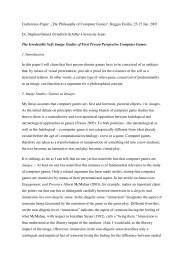Playing Dress-Up: Costumes, roleplay and imagination
Playing Dress-Up: Costumes, roleplay and imagination
Playing Dress-Up: Costumes, roleplay and imagination
Create successful ePaper yourself
Turn your PDF publications into a flip-book with our unique Google optimized e-Paper software.
<strong>Playing</strong> <strong>Dress</strong>-<strong>Up</strong> Ludica<br />
Neverending (Ludicorp 2002-2004; Sugarbaker 2003), which rewarded gifting with “karma<br />
points.”<br />
• Inspecting: Inspecting is a mechanic unique to games with instrumental/armor style mechanics;<br />
it is simply a feature that allows a player to view another player’s armor statistics. This usually<br />
requires permission from the player being inspected, but is a common prelude to provisional<br />
grouping, <strong>and</strong> can also be a means for more experienced players to mentor lower-level players on<br />
armor optimization. This mechanic is unnecessary in games where clothing has no instrumental<br />
or statistical value.<br />
• Fashion Design/Creation: Barbie Fashion Designer, mentioned above, was a watershed for<br />
fashion design in games, which co-designer Bernie DeKoven felt was significant because it:<br />
…wasn't a game, but a utility—a tool that allowed girls to design <strong>and</strong> produce their very own<br />
fashion statements. In many ways, it was like a tool that adult fashion designers use…a<br />
vehicle for the <strong>imagination</strong>—one that respected the creativity of children <strong>and</strong> supported the<br />
aspirational fantasies of girlhood.<br />
(Ludica Interview with Bernie DeKoven, 2006)<br />
In terms of the doll-play mode described above, no single computer game has done more to<br />
advance the cause of digital dress-up than The Sims (2000) <strong>and</strong> its sequels. Its skinning feature<br />
ultimately mushroomed into a worldwide phenomenon. (Pearce 2002; Poremba 2003) Fan sites<br />
such as www.simgrrl.com, which sell player-designed fashions for Sim characters, are testimony<br />
to the effectiveness of this game mechanic in reaching a vast female audience. Subsequent<br />
extension packs of the original game include Celebrity Sims, which allows players to create their<br />
favorite movie <strong>and</strong> rock stars, a play pattern that was originally pioneered by skinning players<br />
themselves. As the best-selling PC game to-date, The Sims has demonstrated not only the appeal<br />
of dress-up in games, but also its marketability across the gender divide. Unlike Barbie Fashion<br />
Designer, which had a decidedly girls-only ethos, The Sims creates a context where both males<br />
<strong>and</strong> females can derive enjoyment from the design aspects of dress-up play.<br />
Renaissance Sim<br />
Source: Cómhair<br />
Egyptian Sims<br />
Source: www.romansims.com<br />
Britney Spears *by jameLia*<br />
Source: www.modthesims2.com<br />
Figure 6: Examples of player-made Sim skins from a variety of sources.<br />
Dracula by Seraphine<br />
Source: www.simsylvania.com<br />
The fashion design mechanic falls into the category of what Pearce terms “productive play”<br />
(Pearce 2006A) <strong>and</strong> appears in different forms, depending on the affordances of the game. In its<br />
Philosophy of Computer Games 2007 Page 8






